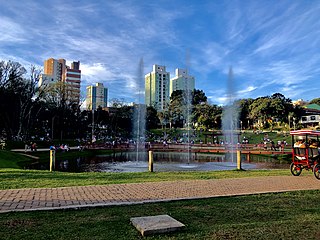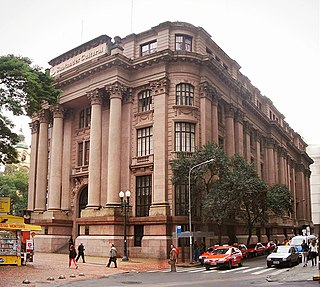
Rio Grande do Sul is a state in the southern region of Brazil. It is the fifth-most populous state and the ninth-largest by area. Located in the southernmost part of the country, Rio Grande do Sul is bordered clockwise by Santa Catarina to the north and northeast, the Atlantic Ocean to the east, the Uruguayan departments of Rocha, Treinta y Tres, Cerro Largo, Rivera, and Artigas to the south and southwest, and the Argentine provinces of Corrientes and Misiones to the west and northwest. The capital and largest city is Porto Alegre. The state has the highest life expectancy in Brazil, and the crime rate is relatively low compared to the Brazilian national average. The state has 5.4% of the Brazilian population and it is responsible for 6.6% of the Brazilian GDP.

Passo Fundo is a municipality in the north of the southern Brazilian state of Rio Grande do Sul. It is named after its river. It's the tenth largest city in the state with an estimated population of 204,722 inhabitants living in a total municipal area of 780 km2.

Polish Brazilians refers to Brazilians of full or partial Polish ancestry who are aware of such ancestry and remain connected, to some degree, to Polish culture, or Polish-born people permanently residing in Brazil. Also, a Polish Brazilian may have one Polish parent.

Rio Grande is a municipality (município) and one of the oldest cities in the Brazilian state of Rio Grande do Sul. It was the state capital from 1835 to 1845. It is the most important port city in the state and has one of the most important maritime ports in Brazil.

Cruz Alta is a municipality in the state of Rio Grande do Sul, Brazil. The town is the seat of the Roman Catholic Diocese of Cruz Alta. Was founded on August 18, 1821.

Ijuí is a Brazilian municipality of Rio Grande do Sul, situated 395 kilometres (245 mi) from the state capital, Porto Alegre. In 2020 its population was 83,764, making it the third most populous city of the Missões region, behind Passo Fundo and Erechim.
Nova Bassano is a municipality and a city in the state of Rio Grande do Sul, south Brazil.

Tucunduva is a municipality in the state of Rio Grande do Sul, Brazil. Known as the Capital of Mechanized Crops, Tucunduva has the highest grain yield per hectare in Brazil and is also known as the Land of Musicians.

The Diocese of Erechim is a Latin Church ecclesiastical territory or diocese of the Catholic Church in Brazil. Its episcopal see is Erechim. The Diocese of Erexim is a suffragan diocese in the ecclesiastical province of the metropolitan Archdiocese of Passo Fundo.
Companhia Zaffari is the tenth largest Brazilian company that has a chain of supermarkets and hypermarkets in Rio Grande do Sul, and São Paulo.
The Federal University of Fronteira Sul is a public, federally-funded Brazilian university serving the interior of Southern Brazil. It was formally founded by act of legislature in September 2009, and planned to graduate 10,000 students within its first five years.
Departamento Aeroportuário (DAP) is the department of aviation of the state of Rio Grande do Sul in Brazil. DAP is part of the Secretaria de Transportes do Governo do Estado do Rio Grande do Sul, and is responsible for the operation of seven public airports within the state, in accordance to directives from the National Civil Aviation Agency of Brazil (ANAC).

Events from the year 1894 in Brazil.
The Campeonato da Região Serrana, commonly known as the Copa Serrana, is an annual competition organized by the Rio Grande do Sul state football federation for clubs that are in the first, second and third divisions of the Campeonato Gaúcho and are located in the mountainous region and northern of the state. It is held in the second half of the year and usually clubs participating in the higher levels of the Campeonato Brasileiro do not participate with the first team squad, using his academy.

Noroeste Rio-Grandense was one of the seven Mesoregions on the state of Rio Grande do Sul in Brazil. It included 216 municipalities grouped in thirteen microregions. The IBGE has since discontinued the microregion system for population tracking, replacing it with the term "immediate geographic region".

Miss Rio Grande do Sul is a Brazilian Beauty pageant which selects the representative for the State of Rio Grande do Sul at the Miss Brazil contest. The pageant was created in 1954 and has been held every year since with the exception of 1990, 1993, and 2020. The pageant is held annually with representation of several municipalities. Since 2023, Bebeto Azevêdo has been the state director of Miss Rio Grande do Sul. Rio Grande do Sul is the state with the most crowns in the national contest and also the state that produced the first Miss Brazil to win the Miss Universe contest, Iêda Maria Vargas of Porto Alegre.
Operation Farroupilha was the temporary transfer of the seat of government of the Brazilian state of Rio Grande do Sul from the Piratini Palace in the capital Porto Alegre to a military brigade barracks in Passo Fundo in the northwest of the state. It was planned by Governor Ildo Meneghetti and executed between April 1 and 3, 1964 as part of the coup d'état in Brazil in 1964.

RBS TV Erechim is a television station in Erechim, Rio Grande do Sul, Brazil, affiliated with TV Globo, member of RBS TV and owned by Grupo RBS. RBS TV Erechim's studios and transmitter are located on Soledade Street, in the Ipiranga district.

RBS TV Santa Rosa is a television station in Santa Rosa, Rio Grande do Sul, Brazil, affiliated with TV Globo, member of RBS TV and owned by Grupo RBS. RBS TV Santa Rosa's studios and transmitter are located on Benvenuto de Conti Street, in Alto do Parque district

Banco da Província was the first commercial bank in the Brazilian state of Rio Grande do Sul. It was founded on July 1, 1858, by Lopo Gonçalves Bastos, João Batista Ferreira de Azevedo and José Antônio Coelho Júnior to facilitate their commercial transactions.



















